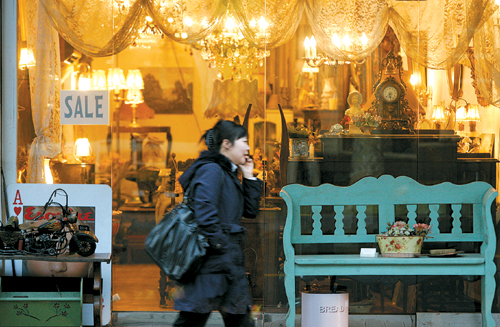Whispers of the past in the shops of Itaewon

A woman walks by one of the many shops that line Itaewon Antique Street in central Seoul. By Jeon Min-kyu
If you come out of exits No. 3 or 4 of Itaewon Station and go along the road leading to Bogwang-dong, you will find a row of furniture stores with old-fashioned chairs and lamp stands set out in front of them on either side of the street. Some of the stores deal in used furniture of all kinds, including pieces that are not so old; others specialize in vintage furniture and items from the first half of the 20th century.
If you turn right at the first three-way junction and go along the road toward the Crown Hotel, there are even more stores, which deal mainly with older and high-end antiques.
Inside one of the stores, Scarlet Antique and Arts, you instantly feel as if you have been transported to the world of a costume drama, with dignified 19th-century oak or walnut tables and cabinets from England, elaborate 18th-century Sevres porcelain clocks with bronze cherubs from France, Rococo-style porcelain figurines from early 20th-century Germany and pretty fans made of silk and ivory, which might have been held by a baroness. The prices of these goods range from hundreds of thousands of won (hundreds of dollars) to tens of millions of won.

Customers look at antiques at Bavaria, an antique shop on Itaewon Antiques Street in central Seoul. By Jeon Min-kyu
“I know a person living in Gwacheon [south of Seoul] who has already collected thousands of pieces of European ceramics.”
She also said Koreans’ interest in Western antiques has increased dramatically in the last decade.
“When I opened this store 13 years ago, there were only about five stores like this,” she said. “But now there are about 90 to 100 stores on this street.”
The history of this area, known here as “Itaewon Antiques Street” goes back to the 1960s, the operators of the antiques shops here said. The shops were set up to accommodate the families of U.S. soldiers stationed in Yongsan District who wanted to sell their furniture when they went home.
Then in the 1990s, stores dealing in goods from Europe that are more than 100 years old also began appearing in the neighborhood.
“In general, goods that are 100 years old and older are called antiques and those with shorter histories are ‘vintage goods,’” said Kim Young-chul, who owns Queens Antiques.
“More and more Koreans have become interested in Western antiques, partly because collectors of Korean antiques now see limits on the number of local antiques,” he added.
He showed a romantic German Polyphon, which is a music box in a cabinet that sits on the floor, from the mid-19th century.
But expensive antiques are not the only things for sale here.
If you enter Bavaria, one of the biggest stores here, you will see all sorts of things ranging from watering pots with peeling paint and old-fashioned home appliances from the 1970s and ’80s in a small yard outside, to lace gloves, venetian mirrors and luxurious mahogany cabinets inside the store.
“The prices of the goods here range from 40,000 won and 50,000 won to hundreds of thousands of won,” said Kim Chung-su, the store’s owner.
“There are trends in antiques collecting,” she said. “When the Western antiques boom first appeared 12 to 13 years ago, collectors favored relatively simple, heavy oak furniture. Then they turned their eyes to more splendid furniture such as Rococo-style pieces.
“Five years ago, ethnic styles were in vogue, with antique and vintage products from Asia, Eastern Europe and Russia gaining popularity,” she continued. “Two or three years ago, vintage pieces made in the 1960s and ’70s, the era of pop art, were in vogue. Nowadays, people’s tastes are more diverse and mixed.”
The shop owners say that people interested in the business need a love and knowledge of antiques and the enthusiasm to go and find them.
“I go to Europe four to five times per year and stay there for 20 days on each trip,” Kim of Bavaria said. “I find products from various places, ranging from auction houses to flea markets.”
“One cannot operate an antiques shop well without a knowledge of European history and culture and a respect and love for the pieces,” Hwangbo said. To share this knowledge, the store has a blog on an Internet portal and gives free hour-long lectures about antiques and the history of European arts and crafts every Saturday afternoon.
By Moon So-young [symoon@joongang.co.kr]










with the Korea JoongAng Daily
To write comments, please log in to one of the accounts.
Standards Board Policy (0/250자)